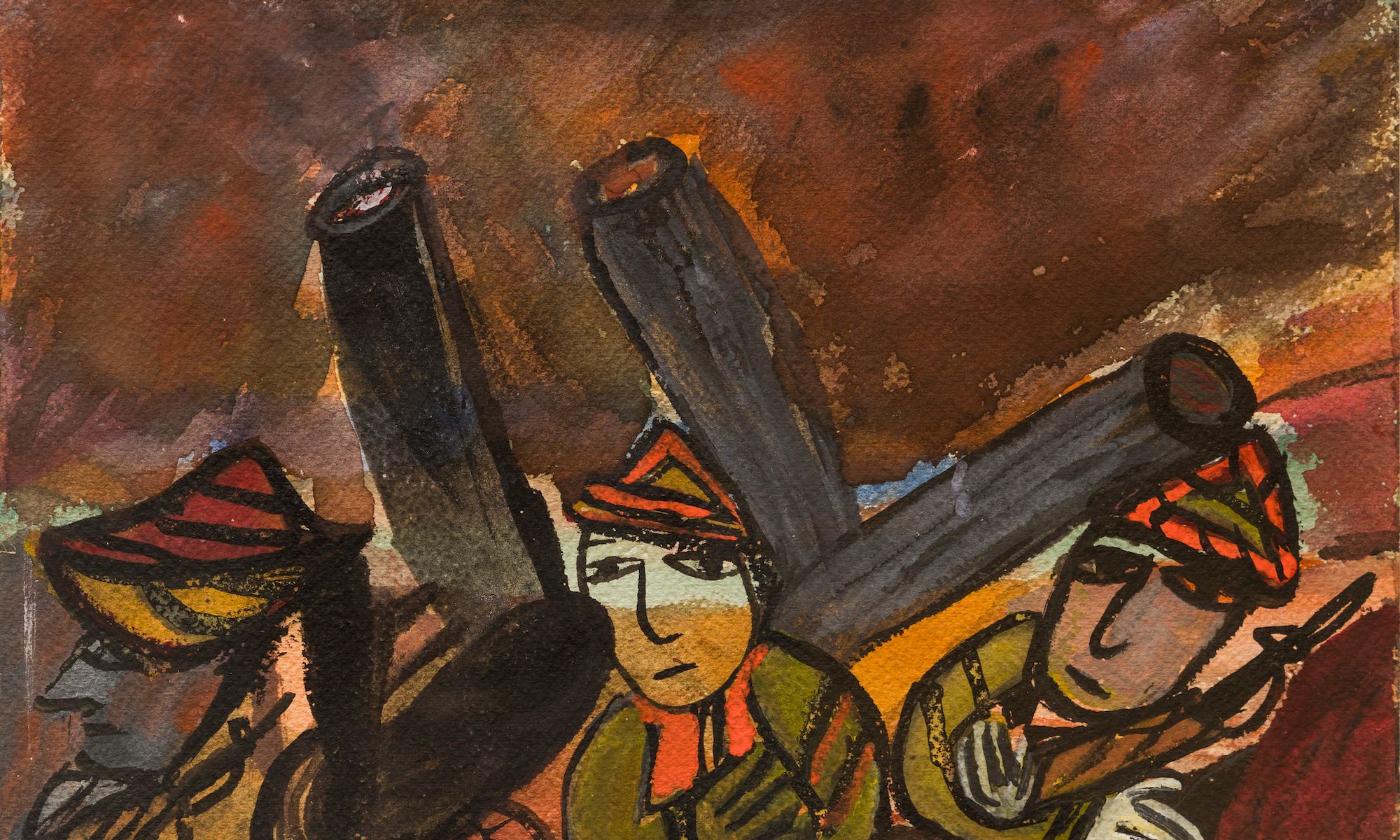Janet Sobel, Untitled, around 1941. Private collection of Gary Snyder Luis Corzo. Courtesy of The Ukrainian Museum, New York
Artist Janet Sobel, a pioneer of drip painting before Jackson Pollock, has been gaining more widespread attention in recent years and, now, is the subject of a solo exhibition at New York’s Ukrainian Museum. The show, Wartime(until 2 September), features Sobel’s stirring primitivist paintings from the early 1940s, which reflect her fears about the Second World War and concerns about the fate of relatives in her native Ukraine.
Peter Doroshenko, the Ukrainian Museum’s director, says he was “dumbfounded” when he encountered Sobel’s work nearly 12 years ago at the Museum of Modern Art. At the time he was returning to the United States from Kyiv (where he had served as the PinchukArtCentre’s founding president), to take over as executive director at Dallas Contemporary.
“She was an artist I had never heard of, but the label said Ukrainian,” says Doroshenko, who is Ukrainian American, and curated Wartime. It was especially striking, he says, because major museums were then unquestioningly identifying Ukrainian-born artists such as Kazimir Malevich as Russian. Since the onset of Russia’s war in Ukraine, that practice has come under scrutiny.
Janet Sobel, Untitled, around 1942. Private collection of Gary Snyder Luis Corzo. Courtesy of The Ukrainian Museum, New York
Sobel, who was born Jennie Olechovsky in Dnipro (then Katerynoslav) in or around 1893, fled from pogroms in which her father is believed to have been killed, and with surviving family members came to New York in 1908. She started painting at age 44, encouraged by her art student son. According to Doroshenko, her works from the time of the Second World War are particularly relevant in light of the current war.
“She had two sons who were stationed in Europe during the Second World War and [was] constantly trying to be in contact with other relatives in Dnipro, and never hearing back from them,” he says. Dnipro is now frequently under Russian bombardment.
The exhibition “starts out with some of her earliest drawings, which were very influenced by Ukrainian folk themes, something that she remembered from Ukraine as a child, and then later saw in the Ukrainian neighborhood in the East Village”, Doroshenko says. “She just started drawing things that she remembered and started intertwining it with her reality at that time.”
Sobel’s work always had a strong figurative component. “Even in the most abstract works, there was always something figurative—eyes, a face, a hand, a silhouette,” Doroshenko says. Sobel burst onto the New York scene with drip paintings, “basically way ahead of her time”, Doroshenko adds, and “other artists such as Jackson Pollock infringed or kind of cribbed her work’s style for their own”. The art critic Clement Greenberg (a friend of Pollock’s) described Sobel’s work as “the first really ‘all-over’ one that I had ever seen”.
Janet Sobel, Untitled, around 1942. Private collection of Gary Snyder Luis Corzo. Courtesy of The Ukrainian Museum, New York
Sobel’s art career was brief. She largely disappeared from the New York scene to focus on raising her five children and supporting her family’s jewellery business, leaving minimal archival traces. She died in 1968.
Former New York gallerist Gary Snyder has championed her work since first showing it in 2002. The works in Wartime are drawn from his private collection. Relatives of Sobel’s who settled in Houston are loaning works for a 2024 show the Menil Collection.Snyder says her full body of work is worthy of close attention, including Surrealist paintings that were known in Max Ernst and Peggy Guggenheim’s circle, and the wartime drawings.
“I was fascinated with this early work, and felt it was less known, but I also was intrigued by all of these images of war, and that became a focus well before I knew how poignant it might be,” Snyder says.“So much of what she painted is spilling out of her mind, her unconscious or her subconscious,” he adds, referring to the influence of Sobel’s childhood in Ukraine. “She is a child. She is under 14 years old. Rather than it being an old person rendering children, she is channelling the young child she was.”
Contemporary artist Lesia Khomenko echoes Sobel’s experience on the museum’s second level in her own solo exhibition, Image and Presence (also until 2 September). Khomenko fled Russia’s invasion with her young daughter while her husband stayed to serve with Ukraine’s armed forces. Four of her series depicting various aspects of war, including the new AJS series (for “After Janet Sobel”), are on display.
Installation view of Lesia Khomenko: Image and Presence at the Ukrainian Museum in New York Courtesy Lilia Kudelia
Khomenko’s works deconstruct Socialist-Realist battle scenes by Soviet Ukrainian artists and addresses war and cyberspace as well as her experience of conflict and evacuation. In the AJS series, she is in dialogue with Sobel on the ruptures and resilience of Ukrainian history.
Khomenko, who recently had her first US solo show at New York’s Fridman Gallery, felt “the strong connection between my practice and her generation”. She says this sense of connection was reinforced by reading Dore Ashton’s The New York School: A Cultural Reckoning (1965), which highlights the role of immigrants in nurturing the city’s Modern art scene.
“I started to research her Second World War period of pre-abstract works and found a lot in common with my own practice,” Khomenko says. She placed Sobel’s “soldiers, simplified figuration, weapons” into a separate canvas and folded them into tubes, so they “are both abstract and referencing to black mortar weapons like in Sobel’s original piece”, bridging generations of Ukrainian diaspora. She adds,“It’s two different histories and I'm looking for a perspective to find something that could unite it all.”

